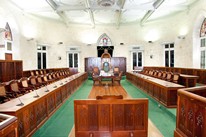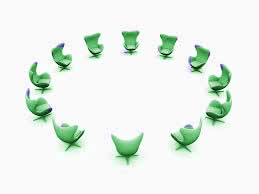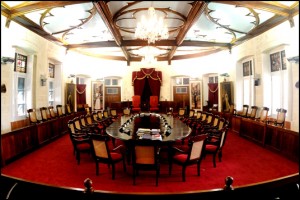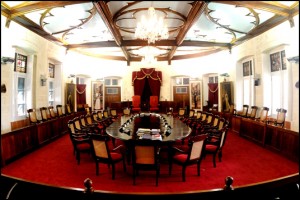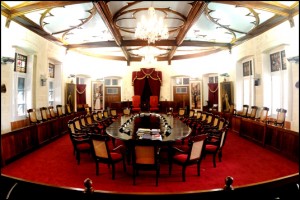The Mace

Originally, a Mace was a symbol of authority, granted by or exercised on behalf of the King or Queen, under a royal warrant including or covering such matters as the collection of taxes. Reluctant taxpayers would find the Mace used as a weapon to enforce their payment and submission. This was the earlier, shorter version of the Mace and was carried by a Sargeant-at-Arms on duty and by soldiers in combat.
King Henry V first arranged in 1415 for a Sargeant-at-Arms, Nicholas Maudit, to wait on the House of Commons with a Mace, the property of the King, as the royal authority by which the privileges of the House would be enforced through the Speaker, a practice which became permanent and continues to this day. The Mace is a symbol of the authority of the Speaker and members of the House.
The Mace of the Barbados House of Assembly is made of silver gilt and was acquired at public expense pursuant to a Resolution passed by the House on November 20, 1810. From 1639 until then there was no Mace.
The Mace is carried by the Sargeant-at-Arms (in Barbados by the Marshal) before the Speaker for the opening and conclusion of each sitting. When the House is in session and when a sitting is suspended, the Mace is placed in a cradle on the Clerk's Table with the orb and cross towards the Government who always sit to the right of a Speaker's Chair in the Commonwealth. When the House is in Committee of the Whole House, and also before the election of a Speaker, the Mace is placed on brackets below the Clerk's Table.
When the House attends the Senate Chamber for a sitting of Parliament (Head of State, Senate and House of Assembly) the Mace is carried before the Speaker and members of the House, who proceed in order of seniority of membership, and it should be left outside the Senate Chamber covered until the Speaker and members of the House of Assembly leave the Chamber.
There is a ceremonial Mace for sittings of the Barbados Parliament. Our Senate does not have a Mace. In some bicameral Parliaments in the Caribbean, for example, in Grenada, each House has a Mace. Some Parliaments in the Caribbean do not have a Mace. The occasional belief that the House of Assembly cannot sit without its Mace has no foundation in law. The Constitution which created the post-independence Parliament does not mention a Mace. But the symbolism of a Mace is fundamental to the traditions of parliamentary institutions. In countries where there are systems of local government, a county, borough, urban or city council will have a Mace.










